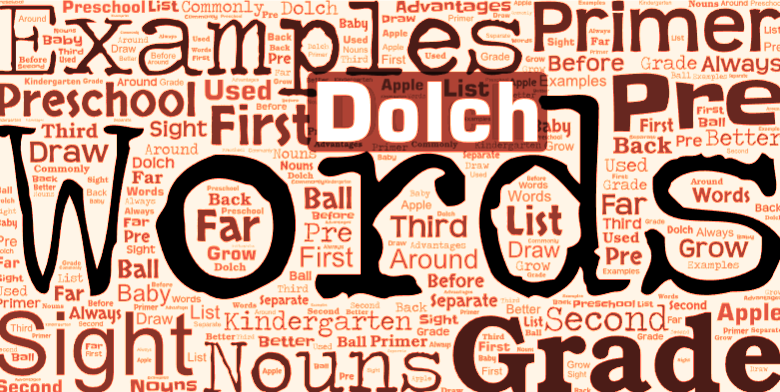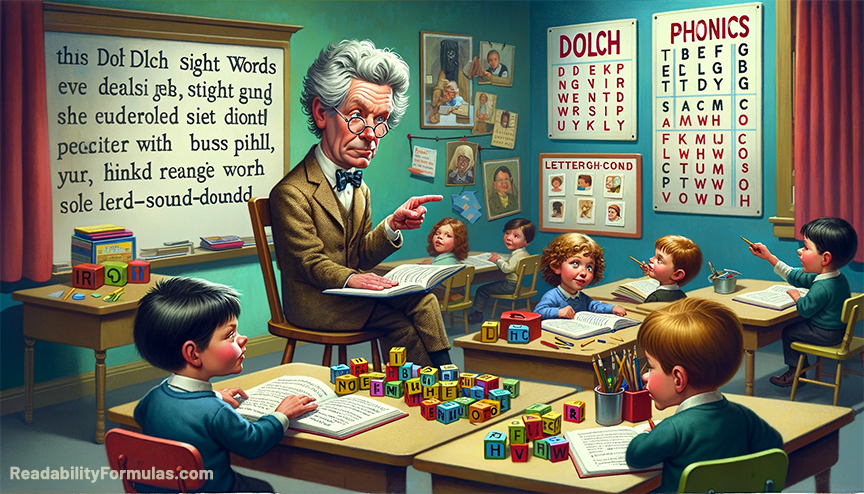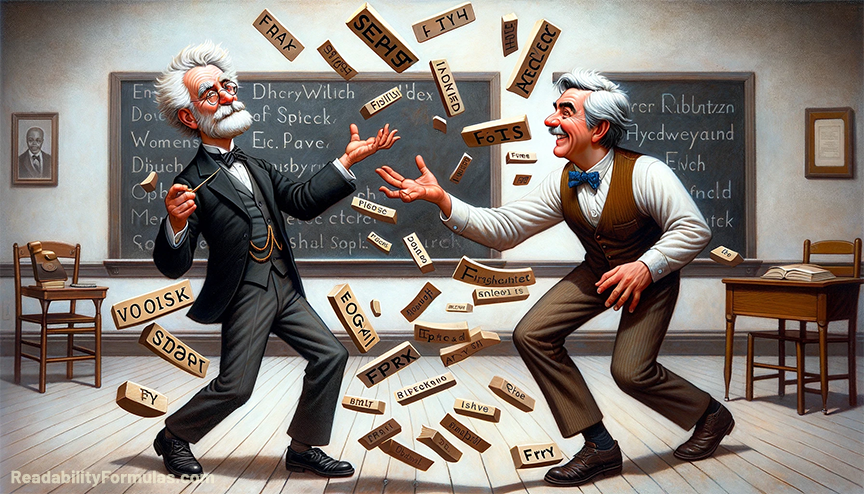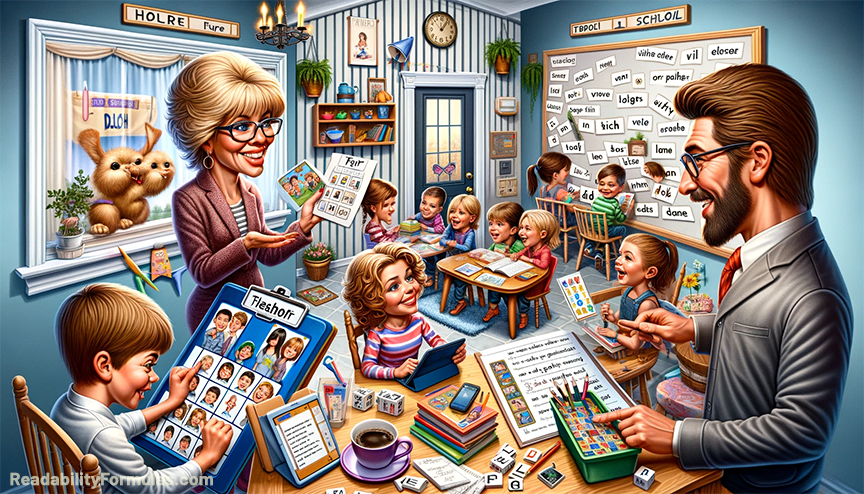Dolch sight words are a set of 220 words and 95 nouns that Dr. Edward William Dolch identified as vital for young children to recognize instantly to achieve reading fluency. He derived this list from high-frequency words in children’s books during the 1930s. He introduced the word list in his book, “Problems in Reading” (1936). These words often defy typical phonetic patterns, making them challenging to decode. Through recognition and practice, they help young readers engage with more complex texts confidently.
Dolch Sight Words Categories
Pre-Primer (Preschool): 40 words | Examples: “a,” “and,” “it,” “to,” “you”
Primer (Kindergarten): 52 words | Examples: “he,” “she,” “that,” “with,” “they”
First Grade: 41 words | Examples: “after,” “has,” “his,” “of,” “them”
Second Grade: 46 words | Examples: “always,” “around,” “because,” “been,” “before”
Third Grade: 41 words | Examples: “about,” “better,” “draw,” “far,” “grow”
Nouns: A separate list of 95 commonly used nouns | Examples: “apple,” “baby,” “back,” “ball”
Advantages of Sight Words
Learning these words facilitates a smoother reading experience, thus minimizing stumbles and hesitations. For example: A child comes across the sentence: “She went to the park.” The child may laboriously sound out words like “she”, “to”, and “the”, disrupting the reading process. Recognizing Sight Words: Reading the same sentence, the child breezes through words they recognize on sight, focusing their decoding efforts only on unfamiliar words like “went” and “park.” This results in a more fluid and confident reading experience. When a child recognizes and reads common words effortlessly, they experience small but consistent moments of success. Each correctly-read word reinforces the belief that they are capable readers.
Recognizing sight words helps children in these real-world examples:
- Restaurant Menu Reading: Imagine a child at a restaurant looking at the menu. If they recognize sight words like “chicken,” “rice,” “with,” “and,” they can easily understand basic food combinations without spending time sounding out every word. Without sight word recognition, even the act of ordering food can become an overwhelming experience.
- Following Classroom Instructions: Teachers will write brief instructions on the board like, “Line up at the door.” A student familiar with sight words can quickly comprehend the instruction and follow through, while others might lag behind, trying to decode “line,” “up,” “at,” and “the.”
- Engaging in Conversations: Recognizing sight words in books and stories helps children maintain the pace of the narrative. For instance, in the sentence: “He gave her a gift,” recognizing words like “he,” “her,” and “a” on sight allows the child to focus on the main action word “gave” and the object “gift.” This not only aids comprehension, but also helps in retelling the story or discussing it with peers.
- Street Signs and Warning Notices: As kids navigate their environment, they encounter numerous signs and notices. Recognizing words like “stop,” “go,” “exit,” and “enter” on sight ensures their safety and helps them understand public directions faster.
- Group Reading Confidence: In classroom settings, group reading is common. Recognizing sight words can make the difference between a child reading fluidly along with peers versus getting caught up, hesitating, or mispronouncing common words. When the sentence is, “The cat sat on the mat,” knowing sight words like “the,” “on,” and “the” can ensure the child only decodes “cat,” “sat,” and “mat,” keeping pace with the class.
- Enjoying Poetry and Songs: Rhythmic patterns in poems and songs can get disrupted if a child stumbles over common words. Knowing sight words allows children to enjoy the rhythm and rhyme scheme without interruptions. For a line like, “The stars shine bright in the night,” recognizing “the,” “in,” and “the” ensures the beauty of the line is not lost.
- Advanced Reading: As children progress to higher reading levels, they encounter more complex sentences. Recognizing sight words becomes crucial. In a sentence like, “Despite the rain, they decided to go outside and play,” recognizing “the,” “and,” and “to” helps focus decoding energy on words like “despite,” “decided,” and “outside.”
In all these scenarios, the theme is the same: sight words act as anchors, helping children navigate the vast ocean of literature and daily language with ease and confidence.
Phonics vs. Sight Words
While Dolch sight words emphasize word recognition, they don’t negate the value of phonics. Phonics is still a foundational skill, especially for early readers, to decode unfamiliar words. (Phonics is a method of teaching reading by correlating sounds with letters or groups of letters in an alphabetic writing system.) A holistic approach to reading instruction integrates both methods—it allows readers to benefit from the strengths of each while compensating for their respective limitations. This combined approach equips readers to tackle a variety of texts with confidence and understanding.
| Sight Words | Phonics | |
|---|---|---|
| Advantages | – Speed: Immediate recognition speeds up reading. – Comprehension: Focus remains on the overall meaning without getting stuck on individual words. – Fluency: Helps in achieving smoother reading. |
– Skill Transfer: Knowledge of sounds can be applied to decode unfamiliar words. – Confidence: Tools to decode words they’ve never encountered. – Structured: Provides a systematic approach to reading based on rules. |
| Disadvantages | – Limitation: Sole reliance doesn’t equip readers with decoding skills. – Memory-Based: Impractical to memorize every word in the language. |
– Irregularities: English has many words that defy basic phonics rules. – Can Slow Reading: Over-relying can hinder fluency if one tries to sound out every word. – Complexity: Some phonics rules can be challenging, and exceptions may confuse. |
Recognizing the strengths and shortcomings of both phonics and sight words has led educators to adopt a balanced approach:
- Early Reading Instruction: When children are first learning to read, teachers will combine phonics (to decode unfamiliar words) and sight words (to promote fluency and comprehension).
- Fluency: As children become more fluent readers, they naturally begin to recognize more words by sight. However, phonics remains essential for decoding unfamiliar words, especially in more advanced texts.
- Adaptable: Depending on the word and the reader’s familiarity with it, they might use phonics, sight recognition, or combine both to read it. For instance, a child might recognize the word “play” on sight but use phonics to decode the unfamiliar word “plausible.”
Fry Sight Words vs. Dolch Sight Words
Dr. Edward Fry introduced the Fry Sight Words in the 1950s based on the most common words used in the English language. He later expanded his word list in the 1980s. The Fry list is more extensive, containing 1,000 words. They account for 90% of words in children’s books and 80% of words in writing.
Comparisons
- Overlap: While both Fry and Dolch lists focus on high-frequency words, many words overlap. Common words like “the,” “and,” “it” appear on both lists.
- Usage: Many educators start with the Dolch list for early readers, given its focus on children’s literature; they then transition to the Fry list to provide a broader vocabulary base.
- Variability: The Fry list, being longer, is more flexible. Some educators might select words from both lists based on students’ needs.
- Adaptability: Both lists were made in the mid-20th century, so some words might be irrelevant today. Educators can adapt the lists based on contemporary literature and students’ backgrounds.
| Criteria | Dolch Sight Words | Fry Sight Words |
|---|---|---|
| History | Compiled by Dr. Edward William Dolch in 1936. | Introduced by Dr. Edward Fry in the 1950s and expanded in the 1980s. |
| Number of Words | 315 words (220 service words + 95 nouns) | 1,000 words |
| Focus | Specific to children’s books of the 1930s and 1940s. | Emphasizes word frequency across all English literature. |
| Grade Levels | Divided into five lists: pre-primer, primer, first grade, second grade, and third grade. | Divided into ten levels, one for each grade from first to tenth. |
| Unique Features | Separate list of 95 nouns. | More comprehensive due to a larger number of high-frequency words. |
Teaching Methods and Strategies
The most popular tools to teach Dolch and Fry words include flashcards, worksheets and interactive games.
Flash Cards
- Materials Needed: Blank cards, markers.
- Procedure:
- Write each sight word neatly on a blank card using the marker.
- Show the flashcard to the student and ask them to read the word aloud.
- Shuffle the cards periodically to prevent the student from memorizing the order.
- As students become familiar with a word, introduce new ones while periodically revisiting old ones for reinforcement.
Word Walls
- Materials Needed: Paper, markers, tape or pins, wall space.
- Procedure:
- Select a section of the classroom or bedroom wall.
- Write each sight word on a piece of paper, making sure it’s large enough to read from a distance.
- Affix each word to the wall using tape or pins.
- Over time, as students master each word, you can highlight or place a mark next to it. This gives students a sense of accomplishment and visually tracks progress.
Sight Word Bingo:
- Materials Needed: Bingo cards, markers or counters, call-out cards.
- Procedure:
- Create bingo cards with a selection of sight words on each square.
- Prepare call-out cards with the same words.
- As you call out a word, students place a marker on the corresponding word on their card.
- The first student to complete a row, column, or diagonal and shouts “Bingo!” is the winner.
Word Memory Match:
- Materials Needed: Blank cards, markers.
- Procedure:
- Write each sight word on two separate cards (so you have pairs).
- Lay all the cards face-down in a grid.
- Students take turns flipping two cards. If they match, the student keeps the pair and gets another turn. If not, they flip the cards back over.
- The game continues until all pairs are found. The student with the most pairs wins.
Reading Practice:
- Materials Needed: Books with simple sentences featuring sight words.
- Procedure:
- Begin by selecting a book that emphasizes many of the sight words.
- Read the book aloud with the student, pointing out the sight words as you come across them.
- Ask the student to identify and read the sight words when they encounter them.
- Over time, encourage the student to read aloud, helping them with pronunciation and comprehension.
- As their proficiency grows, introduce books with more complex sentences but still emphasize the sight words.
The Dolch and Fry sight words are cornerstones for budding readers. The choice between them hinges on the educator’s objectives, the students’ age and reading proficiency, and curriculum demands. Yet, whichever list is selected, the aim is to boost reading fluency and understanding.









